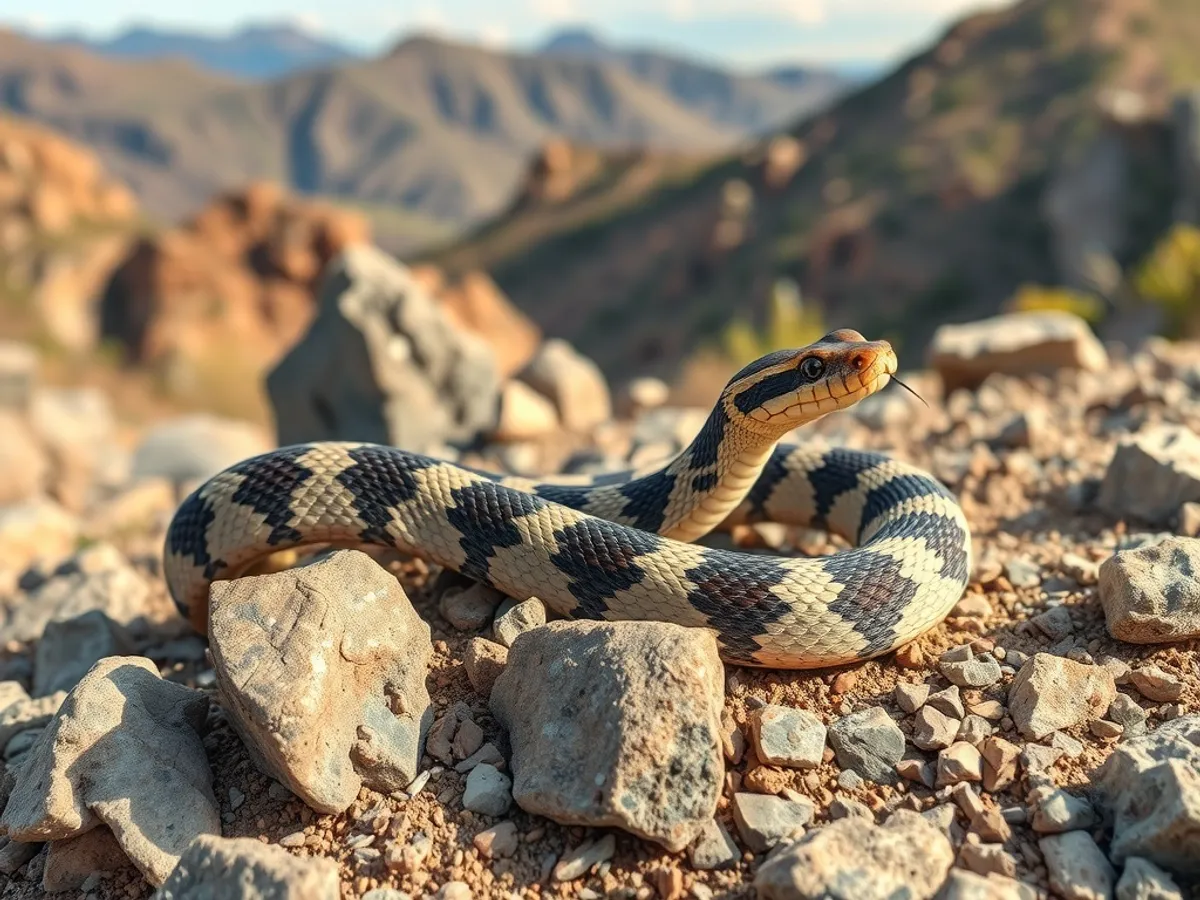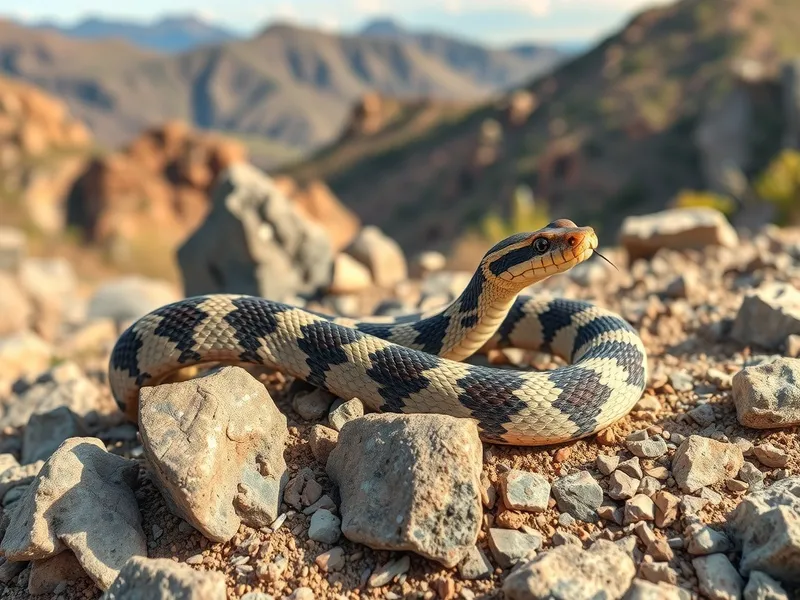
Banded Rock Rattlesnake
Crotalus lepidus klauberi

Meet the Banded Rock Rattlesnake
The Banded Rock Rattlesnake is a small, venomous pit viper native to rocky, mountainous regions of the southwestern United States and northern Mexico. Distinguished by its pale gray to lavender body adorned with dark, well-defined crossbands, this snake is an expert at camouflage among rocks and outcrops. It is a secretive and elusive species, usually active during dusk or after rainfall. Although venomous, it is generally shy and avoids human contact, preferring to remain hidden in crevices.
Classification
Reptile
Habitat
Rocky hillsides and mountainous terrain
Diet
Carnivore
Lifespan
10-15 years
Conservation
Least Concern
Weight
100-300 grams
📖Fascinating Facts
Rocky Specialist
This rattlesnake spends most of its life hidden among rocks and boulders, making use of crevices for shelter and hunting.
Color Variability
The coloration and pattern of Banded Rock Rattlesnakes can change dramatically depending on their geographic location, helping them blend into local environments.
Heat Sensing Pits
Like all pit vipers, they possess heat-sensing pits between the eyes and nostrils to detect warm-blooded prey even in total darkness.
📋Detailed Description
The Banded Rock Rattlesnake (Crotalus lepidus klauberi) is a small to medium-sized pit viper, typically measuring 40–70 cm (16–28 in) in total length, with some individuals reaching up to 80 cm (31 in). Its robust body is characterized by a pale gray, bluish, or lavender background color, overlaid with 18–22 sharply defined dark crossbands that provide exceptional camouflage among rocky substrates. The head is broad, triangular, and distinct from the neck, with large, heat-sensitive loreal pits between the eyes and nostrils, enabling precise detection of warm-blooded prey. Scales are keeled, enhancing both grip and cryptic coloration. The tail is relatively short and ends in a segmented rattle, which is used defensively. Eyes possess vertical pupils adapted for low-light vision. This species is primarily nocturnal or crepuscular, especially during the hot summer months, and is highly secretive, spending much of its time concealed in rock crevices or under stones. Its venom is primarily hemotoxic, adapted for subduing small vertebrate prey, but is generally not considered life-threatening to healthy adult humans. The Banded Rock Rattlesnake is a sit-and-wait ambush predator, relying on its camouflage and patience to capture prey. Sexual dimorphism is subtle, with males often slightly longer and having proportionally longer tails than females.
💡 Did you know?
Despite their potent venom, Banded Rock Rattlesnakes are extremely reclusive and bites to humans are exceedingly rare.
🔬Research & Sources
Wikipedia Summary
Crotalus lepidus klauberi is a venomous pitviper subspecies native to the southwestern United States and adjacent northern Mexico.
Last Modified: 9/18/2024
🎭Behavior & Social Structure
Crotalus lepidus klauberi is a solitary and secretive species, rarely seen in the open except during the breeding season or after rainfall. It is an ambush predator, remaining motionless for extended periods while waiting for small mammals, lizards, or occasionally birds to approach. Its primary hunting times are dusk and night, taking advantage of cooler temperatures and increased prey activity. When threatened, it may vibrate its rattle as a warning, but often relies on remaining motionless to avoid detection. The species is not aggressive and will retreat if given the opportunity. Activity is highly seasonal, with peak surface activity in late spring and early summer, and reduced activity during the hottest and coldest months. Banded Rock Rattlesnakes exhibit strong site fidelity, often returning to the same refugia year after year. Social interactions are minimal, though males may engage in ritualized combat during the breeding season.
👶Reproduction & Life Cycle
The Banded Rock Rattlesnake is ovoviviparous, giving birth to live young rather than laying eggs. Mating typically occurs in late spring to early summer (April–June), with males actively searching for receptive females. Courtship involves tongue-flicking and body alignment, and males may engage in combat for access to females. After successful copulation, females undergo a gestation period of approximately 4–5 months. Litters of 2–8 neonates are born in late summer or early fall (August–September), each measuring about 18–23 cm (7–9 in) in length. Neonates are fully independent at birth, equipped with functional venom glands and a small button rattle. There is no parental care beyond birth, and reproductive frequency is generally biennial, with females often breeding every other year depending on resource availability.
🛡️Adaptations & Survival
Crotalus lepidus klauberi exhibits several adaptations for survival in arid, rocky environments. Its cryptic coloration and banded pattern provide effective camouflage against lichen-covered rocks and scree, reducing predation risk. The heat-sensing loreal pits allow precise detection of endothermic prey even in total darkness. Keeled dorsal scales enhance grip on uneven rocky surfaces. The rattle serves as a warning device to deter large predators. Behavioral adaptations include nocturnality and crepuscular activity to avoid extreme daytime temperatures and desiccation. Physiologically, the species can tolerate significant fluctuations in temperature and humidity, and can survive long periods without food or water by reducing metabolic rate. Its venom is specialized for rapid immobilization and digestion of small vertebrates, with a composition that varies geographically.
🎨Cultural Significance
The Banded Rock Rattlesnake has limited direct cultural significance due to its secretive nature and restricted range. However, rattlesnakes in general hold a prominent place in the folklore and mythology of indigenous peoples of the American Southwest, often symbolizing fertility, transformation, or danger. In modern times, the species is occasionally featured in herpetological ecotourism and educational programs, highlighting the importance of venomous snakes in ecosystem health and biodiversity. There are no known traditional medicinal or utilitarian uses specific to this subspecies.
🔬Recent Research & Discoveries
Recent research on Crotalus lepidus klauberi has focused on its population genetics, revealing significant genetic structuring between isolated mountain ranges (sky islands), which may have implications for conservation management. Studies of venom composition have documented intraspecific variation, potentially linked to local prey availability. Ongoing telemetry and mark-recapture studies are shedding light on home range size, movement patterns, and habitat use. Climate change modeling is being used to predict future range shifts and identify critical refugia. The species is also of interest in studies of crypsis and predator-prey dynamics in arid environments.
🎥Wildlife Videos

Rattlesnakes of Arizona - 9 species of venomous pit vipers from Sonoran desert
Living Zoology team was filming rattlesnakes in Southwestern USA and found 72 individuals of 9 species! This video contains ...
Living Zoology

The Desert of Rattlesnakes - full nature documentary, venomous rattlesnakes of Arizona
https://livingzoology.com/ by Matej Dolinay and Zuzana Dolinay The North America was once an uninhabited wilderness where ...
Living Zoology

The Lethal Western Diamondback Rattlesnake | Real Wild
The deserts of America‚ South West are home to the most notorious of all snakes - the Western Diamondback Rattlesnake.
Real Wild

My Banded Rock Rattlesnake - Crotalus lepidus klauberi
a quick video to show the intense green coloration of my banded rock rattlesnake from the Black Range of New Mexico. Click on ...
Erik McCormick

The Notorious Western Diamondback Rattlesnake | Our World
But this image of the rattlesnake is only part of its story. Few of us will ever see a rattlesnake in the wild, and they are not confined ...
Our World

Confronting USA's most Lethal Snakes | Ten Deadliest Snakes with Nigel Marven | @UltimateNatureDocs
The USA is the land of the rattlesnake, with over 30 species of rattler found here. But what's the deadliest serpent in the country?
Ultimate Nature Documentaries
🌍Habitat Information
The Banded Rock Rattlesnake typically inhabits Rocky hillsides and mountainous terrain environments. Banded Rock Rattlesnakes have adapted to their environments with specialized features and behaviors.
Primary Habitat:
Rocky hillsides and mountainous terrain
More detailed habitat information will be available soon.
🛡️Conservation Status
The Banded Rock Rattlesnake is currently classified as Least Concern. Conservation efforts are crucial for preserving this species for future generations.
Common Threats:
- 🏠Habitat loss and fragmentation
- 🌡️Climate change impacts
- 🎯Hunting and poaching
- 🏭Human-wildlife conflict
⚠️Threats & Conservation Challenges
While currently listed as Least Concern, Crotalus lepidus klauberi faces localized threats from habitat destruction due to mining, urban development, and recreational activities in mountainous regions. Illegal collection for the pet trade and road mortality also pose risks to some populations. Climate change may alter the availability of suitable microhabitats and prey species. Despite these challenges, the species' secretive habits and remote habitat preferences offer some protection. Population trends are generally stable, but localized declines have been reported in areas with increased human encroachment.
🔬Scientific Classification
Scientific Name
Crotalus lepidus klauberi
Classification Hierarchy
🔍 About Taxonomic Classification
Taxonomic classification is a hierarchical system used by scientists to classify and organize living organisms based on shared characteristics and evolutionary relationships.
The system moves from broad categories (Kingdom) to increasingly specific ones, with each animal's scientific name typically consisting of its Genus and species.
📝Community Notes
Share your observations and insights about the Banded Rock Rattlesnake with our community of wildlife enthusiasts.
Join Our Community
Sign in to share your observations and connect with fellow wildlife enthusiasts.
Sign In to ContributeNo community notes yet
Be the first to share your observations about the Banded Rock Rattlesnake!
Explore Banded Rock Rattlesnake
Select a tab above to learn more about this amazing animal.
📸Photo Gallery
No photos available for this animal yet.
🌟Discover More Wildlife
Continue your journey of discovery with more fascinating animals from our database
